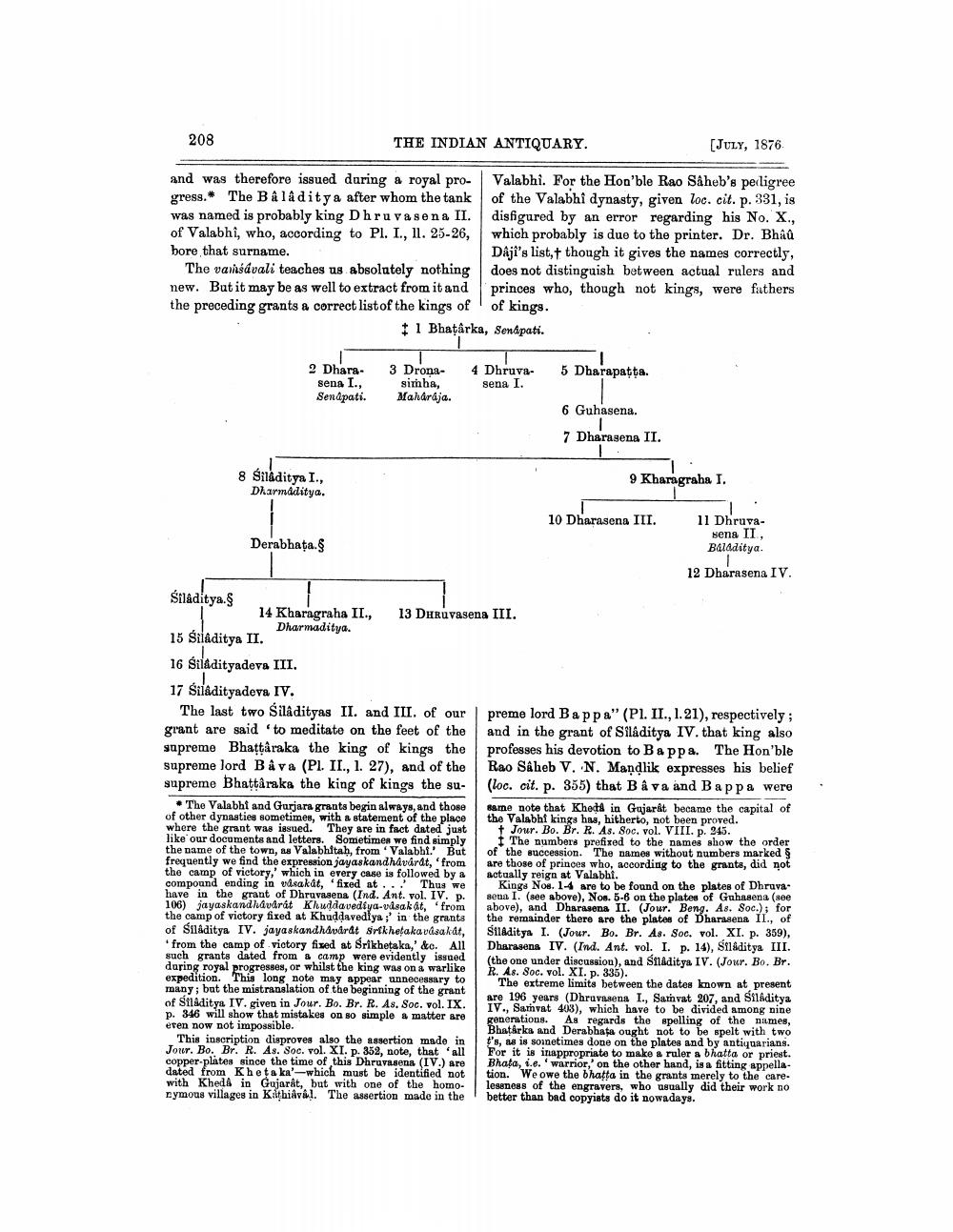________________
208
THE INDIAN ANTIQUARY.
[JULY, 1876
and was therefore issued during a royal pro- Valabhi. For the Hon'ble Rao Saheb's peligree gress.* The Bâlâditya after whom the tank of the Valabhi dynasty, given loc. cit. p. 331, is was named is probably king Dhru vasena II. disfigured by an error regarding his No. X., of Valabhi, who, according to Pl. I., 11. 25-26, which probably is due to the printer. Dr. Bhâû bore that surname
Daji's list, though it gives the names correctly, The variśdvali teaches us absolutely nothing does not distinguish between actual rulers and new. But it may be as well to extract from it and princes who, though not kings, were fathers the preceding grants a correct list of the kings of of kings.
11 Bhatarka, Senapati.
2 Dhara. sena I., Senapati.
5 Dharapatta.
3 Drona-
simha, Maharaja.
4 Dhruva
sena I.
6 Guhasena.
7 Dharagena II.
8 Siladitya I.,
Dharmaditya.
9 Kharagraha I.
10 Dharasena III.
11 Dhruva
sena II, Baladitya.
Derabhata.
12 Dharasena IV.
Śladitya.
14 Kharagraha II.,
13 Dhruvasena III.
Dharmaditya.
15 Siladitya IT
16 siladityadeva III. 17 Siladityadeva IV.
The last two Šiladityas II. and III. of our grant are said to meditate on the feet of the supreme Bhattâraka the king of kings the supreme lord Bava (Pl. II., 1. 27), and of the supreme Bhattâ raka the king of kings the su
• The Valabht and Gurjara grants begin always, and those of other dynasties sometimes, with a statement of the place where the grant was issued. They are in fact dated just like our documents and letters. Sometimes we find simply the name of the town, as Valabhitah, from Valabht.' But frequently we find the expression jayaskandhavardt, 'from the camp of victory,' which in every case is followed by a compound ending in vasakåt, 'fixed at ... Thus we have in the grant of Dhruvasena (Ind. Ant. vol. IV. p. 106) jayaskandhaudrát Khuddavediya-visakat, from the camp of victory fixed at Khuddavedlya ;' in the grants of Siladitya IV. jayaskandhavarat srikhetaka vdsakát,
from the camp of victory fixed at Srikhetaka,' &c. All such grants dated from & camp were evidently issued during royal progresses, or whilst the king was on & warlike expedition. This long note may appear unnecessary to many; but the mistranslation of the beginning of the grant of Siladitya IV. given in Jour. B. Br. R. As. Soc. vol. IX. p. 346 will show that mistakes on so simple matter are eren now not impossible.
This inscription disproves also the assertion made in Jour. Bo. Br. R. As. Soc. vol. XI. p. 352, note, that all copper-plates since the time of this Dhruvasena (IV.) are dated from Kheta ka'-which must be identified not with Khed in Gujaråt, but with one of the homo. Lymous villages in Kathiával. The assertion made in the
preme lord Bappa" (P1. II., 1.21), respectively; and in the grant of Siladitya IV. that king also professes his devotion to Bappa. The Hon'ble Rao Sâheb V. N. Mandlik expresses his belief (loc. cit. p. 355) that Bâ va and Bappa were same note that Khede in Gajarkt became the capital of the Valabht kings has, hitherto, not been proved.
+ Jour. Bo. Br. R. As. Soc. vol. VIII. p. 945.
I The numbers prefixed to the names show the order of the succession. The names without numbers marked are those of princes who, according to the grants, did not actually reign at Valabhi.
Kings Nos. 1-4 are to be found on the plates of Dhravasena I. (see above), Nos. 5-6 on the plates of Guhasena (see above), and Dharasena II. (Jour. Beng. As. Soc.); for the remainder there are the plates of Dharmena II., of Staditya L. (Jour. Bo. Br. As. Soc. vol. XI. p. 369), Dharasena IV. (Ind. Ant. vol. I. p. 14), Siladitya III. (the one under discussiou), and Siladitya IV. (Jour. Bo. Br. R. As. Soc. vol. XI. p. 335).
The extreme limits between the dates known at present are 196 years (Dhruvasena I., Samvat 207, and Siladitya IV., Samvat 408), which have to be divided among nine generations. As regards the spelling of the names, Bhatarka and Derabhata ought not to be spelt with two t's, mais soinetimes done on the plates and by antiquarians. For it is inappropriate to make a ruler a bhatta or priest. Bhata, i.e.' warrior,' on the other hand, is a fitting appellation. We owe the bhatta in the grants merely to the careleseness of the engravers, who usually did their work no better than bad copyints do it nowadays.




